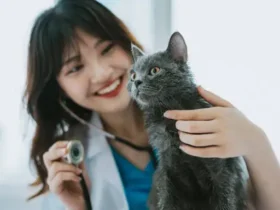Introduction
If you’re a cat owner or simply curious about feline biology, you may have wondered, “Do cats have periods?” The answer is a bit more complicated than a simple yes or no. While female cats don’t experience menstrual periods like humans, they do go through a reproductive cycle that includes phases where they might display behaviors and physical signs that resemble a period. In this blog, we’ll dive into the details of a cat’s reproductive cycle, explain the difference between human menstruation and feline estrus, and share expert advice from veterinarians on what to expect and how to care for your cat during these times.
Understanding the Feline Reproductive Cycle
1. The Estrous Cycle: The Feline Version of “Periods”
- Unlike humans, cats don’t have a menstrual cycle but an estrous cycle, commonly referred to as being “in heat.” This cycle is a crucial part of a cat’s reproductive system and can occur multiple times a year, especially in unspayed female cats.
- Phases of the Estrous Cycle:
- Proestrus: The beginning of the cycle, where the cat might become more affectionate and vocal, but there’s no visible discharge.
- Estrus: This is when the cat is receptive to mating. Behavioral changes like excessive vocalization, restlessness, and a noticeable increase in affectionate behavior are common. Unlike human menstruation, there’s no shedding of the uterine lining, so there’s no bleeding.
- Interestrus: If the cat doesn’t mate, she’ll go into a resting phase before the cycle starts again.
- Anestrus: A period of inactivity in the reproductive cycle, usually during the shorter daylight months.
2. Key Differences Between Human Menstruation and Feline Estrus
- Bleeding: Human menstruation involves the shedding of the uterine lining, resulting in bleeding. Cats do not have this kind of menstrual bleeding. If you notice blood, it might be due to another health issue that requires veterinary attention.
- Cycle Length: Human menstrual cycles average 28 days, while a cat’s estrous cycle can vary significantly, often occurring every two to three weeks during breeding seasons.
- Hormonal Changes: Both humans and cats experience hormonal changes during their cycles, but the effects differ. Cats primarily show behavioral changes rather than physical symptoms like cramps or mood swings that are common in humans.
Signs Your Cat Is in Heat
1. Behavioral Changes
- Increased Vocalization: Cats in heat are often much louder, meowing, yowling, or even howling to attract a mate.
- Restlessness: Your cat may pace around the house more frequently, seeming anxious or agitated.
- Affectionate Behavior: Cats may become unusually affectionate, rubbing against furniture, walls, and even their owners more than usual.
- Raised Hips and Tail: Cats in heat will often display a posture with their hindquarters raised and tail to the side, signaling their readiness to mate.
2. Physical Signs
- Excessive Grooming: Cats may lick their genital area more frequently during heat, although this is not associated with bleeding.
- Swollen Genitals: Some cats may exhibit slight swelling of the vulva during heat, though this is not always noticeable.
What to Do If Your Cat Is in Heat
1. Keeping Your Cat Comfortable
- Provide Extra Attention: Engage in more playtime and offer comfort to soothe your cat’s restlessness.
- Create a Calming Environment: Use pheromone diffusers or sprays to reduce stress and anxiety.
- Avoid Outdoor Access: An indoor-only environment is crucial to prevent unwanted pregnancies if your cat is not spayed.
2. Considering Spaying
- Benefits of Spaying: Spaying eliminates the estrous cycle, preventing the behavioral changes associated with heat and reducing the risk of certain health issues like pyometra (a uterine infection) and certain cancers.
- When to Spay: Veterinarians typically recommend spaying before the first heat cycle, usually around six months of age, but it can be done at any age depending on your cat’s health.
Common Myths About Cats and “Periods”
1. Myth: Cats Bleed During Their Heat Cycle
- Fact: Unlike dogs, cats do not typically bleed during their heat cycle. If you notice blood, it could indicate a medical issue, not a normal part of the estrous cycle.
2. Myth: Cats Feel Pain During Estrus
- Fact: There is no evidence to suggest that cats experience pain similar to menstrual cramps. However, they may feel discomfort or stress, which is why it’s essential to keep them calm and comfortable.
When to Consult a Veterinarian
1. Unusual Bleeding or Discharge
- If you notice any bleeding or unusual discharge from your cat’s genital area, it’s vital to consult a vet. This could indicate an infection, injury, or another health problem.
2. Excessive Crying or Distress
- While vocalization is normal during heat, excessive crying, or signs of severe distress should be evaluated by a veterinarian to rule out underlying health issues.
3. Health Concerns with Repeated Heat Cycles
- If your cat goes through repeated heat cycles without mating, she may be at risk of developing health issues like ovarian cysts or pyometra. Spaying is a preventive measure against these conditions.
Conclusion
While cats don’t have periods in the same way humans do, they do experience an estrous cycle that can cause significant behavioral and physical changes. Understanding these cycles can help you better care for your feline friend and make informed decisions about her health. If you’re ever in doubt about your cat’s reproductive health, consulting a veterinarian is always the best course of action.











Leave a Reply